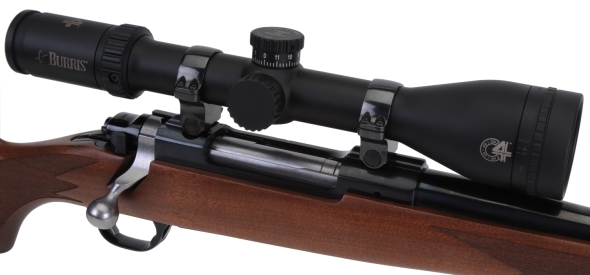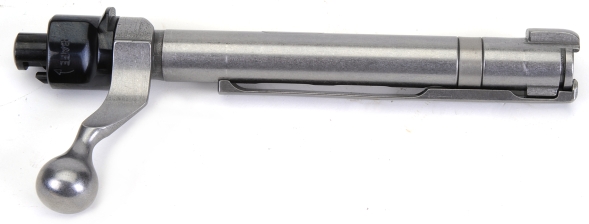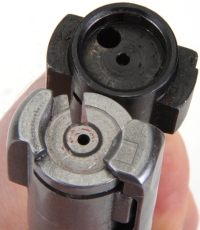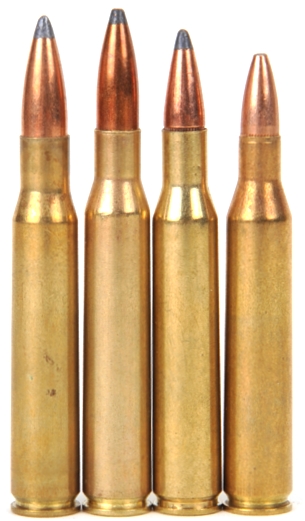
Today would have to be descriptively recorded as,,, interesting. It started with a skunk occupying a trap set for squirrels, a contractor almost being blown off the roof in high winds and an all day ATF compliance audit. The skunk, set free, was last seen heading toward my neighbor’s home, the contractor knocked off for the day before he was an unwilling participant in a high dive and the ATF agent proved to be polite, professional and efficient. All and all, a pretty good day. Still, it’s 12:05 AM and I need to finish this article that I haven’t been able to quite finish for the past few days.
Usually, I work with a firearm for a while, develop some handloads, shoot it for a while to get a feel for its operation, handling characteristics and ballistic performance. Then I sit down and write a few thousand words until I eventually figure out what I am trying to say about the firearm and/or cartridge. Here goes…
In 1968, I took a 275 – 300 yard shot at a Black Hills prairie deer with a 243 Winchester, and then a second shot to finish it off. The first shot was a little low, the second was a clean heart shot, but neither bullet expanded much and neither passed through. The next season, equipped with a different rifle, I took a 350 – 375 yard shot, the longest shot I had ever attempted and the deer dropped immediately. That was my first experience with the 25-06 Remington, just about a year before Remington changed it from a wildcat to a factory round.
The 25-06 Remington version of the Ruger M77 Hawkeye Standard differs from other non-magnum firearms within the series. It has a 24″ barrel with a profile that is consistent with belted magnum versions, rather than a 22″, lighter profile barrel as utilized with other non-magnum cartridges like the 30-06 Springfield and 270 Winchester.
|
Ruger M77 Hawkeye Standard |
|
| Manufacturer | Ruger Firearms |
| Model | Cat.# HM77R Mod.# 37120 |
| Type | Bolt Action |
| Caliber | 25-06 Remington |
| Magazine Capacity | 4 |
| Barrel Length | 24“ |
| Rifling | 1:10″ 6 Groove RH |
| Weight | 8.25 Lbs |
| Overall Length | 44.75“ |
| Stock | Walnut |
| Hardware | Blued Gloss |
| Length of Pull | 13.50″ |
| Drop at comb | 0.50″ |
| Drop at heel | 0.75″ |
| Rear Sight | Clean |
| Front Sight | Clean |
| Scope | Ruger Integral Mounts |
| Rings | 1″ Included |
| Trigger | LC6™ Non-Adjustable |
| Trigger Pull | 4 lbs. 9 oz. |
| Safety | 3 Position Thumb |
| MSRP | $899 |
| Online Retail | $644 |
| Also available in: 204 Ruger, 223 Rem, 22-250 Rem, 243 Win, 25-06 Rem, 257 Roberts, 270 Win, 6.5 Creedmoor, 7mm-08 Rem, 7mm Rem Mag, 308 Win, 30-06 Springfield, 300 Win Mag, 338 Win Mag. | |
The 25-06 Remington version carries a bit of extra weight, but then it is spec’d for long range applications, not as a rifle that will be hauled around in densely wooded hill country. The extra weight is strictly in the barrel as the stock is standard sporter weight with no overly wide forearm or palm swelled pistol grip. Subsequently, the rifle is comfortable shooting from all field positions, except perhaps contradictory, precarious and/or fetal.
An understated quality…
Sturm, Ruger & Co., Inc. firearms tend to be conservative in appearance. The M77 Hawkeye Standard’s stock has well thought out, but very straight forward geometry. The satin finish is durable, sealed against the effects of harsh weather conditions and scratch resistant. The checkering patterns are clean and functional, all hardware is bright blued steel or stainless. There is no suggestion of an owner’s desperate cries for attention.
The M77 is cleanly inletted with uniform pressure points between stock and the M77’s flat bottomed receiver. The sporter profile barrel floats out to the pressure pad at the end of the barrel channel, however, side channel inletting varies from close to contact.

The hardware is all steel, including bottom metal and even the magazine follower. The floorplate release is recessed into the face of the trigger guard; out of the way to prevent accidental release, but conveniently located when needed. The only exception to steel pieces is the crested decorative grip cap, which is poly, but it is nicely done.
Ruger’s proprietary scope mount system, where the scope base function is integrated into the receiver, eliminates the need for separate bases; fewer pieces to work loose or to increase scope height unnecessarily. Additionally, the Ruger rings are keyed to the top of the rifle’s receiver, which eliminates any possible fore and aft movement. For diehards who won’t part with Weaver type rings, adapters are available at Brownells. For folks who want quick detach Ruger rings, they are available at the Ruger Shop.

Ruger includes a set of 1″ rings with each M77, blue or stainless dependent upon the firearm type. Ruger customer service will exchange new, unaltered rings received with a recently purchased rifle for rings of different height or for a different diameter scope tube. For specifics, contact Ruger Customer Service.
Similar, but quite different
The stainless steel twin lug bolt has a 90º lift. Its non-rotating Mauser type claw extractor provides an extra measures of extraction reliability. The dog leg bolt handle assure maximum eye piece clearance with the lowest possible rings to keep line of sight closest to bore centerline and to minimize that angle of incidence.

The M77 has a three position safety; bolt locked safe, bolt free safe and fire. When the in the bolt locked safe position, the wing safety locks into the rear of the firing pin assembly and physically blocks its path in addition to locking the bolt closed.
 The Ruger M77 is a control feed rifle as shown, bottom right. When a cartridge is fed from the rifle’s magazine, it is pushed against the boss formed at the front of the far locking lug and slipped under the extractor claw on the opposite side then guided forward into the rifle’s chamber. Gravity has no bearing on the process. Unlike some controlled feed firearms, the M77 can be single loaded by placing a round in the chamber and closing the bolt. The slot in the Ruger bolt face is clearance for the blade type ejector.
The Ruger M77 is a control feed rifle as shown, bottom right. When a cartridge is fed from the rifle’s magazine, it is pushed against the boss formed at the front of the far locking lug and slipped under the extractor claw on the opposite side then guided forward into the rifle’s chamber. Gravity has no bearing on the process. Unlike some controlled feed firearms, the M77 can be single loaded by placing a round in the chamber and closing the bolt. The slot in the Ruger bolt face is clearance for the blade type ejector.
By comparison, the Remington, top right, is push feed. It has a plunger type ejector located in its bolt face and a small stamped steel nib extractor riveted or clipped inside the rim of its bolt face. Earlier, I used the term “conservative” when describing the Ruger M77 Hawkeye and, I think, what has just been noted is a good illustration.
Does a rifle have to be control feed? No. Does it have to have a major claw extractor? No. But the design is derived from weapons designed for absolute reliability under combat situations where life often hangs in the balance. Perhaps Ruger recognizes that we are all not all just sport deer hunters and knows that when subsistence hunting, and hunting dangerous game with teeth and claws, assurances of positive feed and extraction are a good idea.

Pictures… The tools of a woefully mediocre writer

I have to say, I kind of like the word “woefully”. It’s sort of fun to say… almost British. “You are woefully lacking in discipline, Sergeant Major, and I shall throttle you if you don’t begin to pull your own weight. Try being more like Frobisher or Chatsworth over there”. I miss Monty Python. Anyway…
Pictured left, 30-06 Springfield, 280 Remington, 270 Winchester, and 25-06 Remington. The latter three began life as wildcat versions of the 30-06 Springfield dating back to the 1920s. The chronological development of the family goes something like this, L-R: 30-06 Springfield 1906, 280 Remington 1957, 270 Winchester 1925, 25-06 Remington 1969.
During the 1920s, the progressive burning properties of smokeless powder were being exploited and the trend toward smaller bores and larger cases was in full swing. All the kids were doing it. Both factories and accomplished gunsmiths, like the 25-06’s A.O. Neidner, were either developing or standardizing wildcat cartridges.
It was a blissful time, generally devoid of chronographs, pressure checking equipment and live fire derived ballistic coefficients. Quite unlike today, where a great deal of substantiating data exists, even if people often choose to ignore it – AKA Flat Earth Society and Wiki referenced wisdom.
Theoretical, anecdotal and empirical… words I’d use if they applied
What the 25-06 Remington has going for it is cheap brass and high velocity. What is has working against it is bullet selection or, more specifically, an absence of bullets with very high sectional density and/or high ballistic coefficient that would help to increase it’s retained velocity. Where heavier 0.243″ and 0.264″ bullets can be characterized as having high SD and BC, the 0.257″ bullet cannot. At the top of weight for the respective calibers the numbers would look like: 0.243″ 107 grain SD 0.259 BC 0.527, 0.257″ 117 grain SD 0.253 BC 0.410 and 0.264″ 142 grain SD 0.291 BC 0.595. This may seem like splitting hairs, however, if the 25-06 Remington bullet had the same BC as the 0.264″ bullet, at 500 yard it would be traveling 300+ fps faster, carrying over 400 ft-lbs more kinetic energy and drop would be 6″+ less. So how does a 25 caliber find its legs? You make it go faster.

For deer, black bear and hog hunting from close in, out to 200 to 250 yards, the 257 Roberts, far right, with its 56 grains of powder capacity is more than enough cartridge. With an increase in capacity of approximately 10 grains, but a boost of nearly 15,000 PSI in peak pressure, the 25-06 Remington is a 325 yard point blank cartridge with 117 grain bullets. That’s a length of over three football fields without hold over and five football fields with a bit of holdover and still pulling a half ton of kinetic energy.
The 257 Weatherby Magnum, near right, holds approximately 20 grains more than the 25-06 Remington and operates at approximately the same 65,000 PSI pressure level. Shoot all three cartridges through a 24″ barrel with 117 – 120 grain bullets and you get, as pictured right, right to left: 2800 fps, 3,100 fps and 3,250 fps. The 25-06 Remington is a good balance of shooting power and cost and a good balance of longevity and cost of equipment.
For folks willing to spend the time researching bullets a bit, there are some specialized products that can make the 25-06 Remington an easy 500 yard antelope and deer rifle… assuming the shooter is up to the task. A solid copper GS Custom HV Hunting bullet, with multiple thin driving bands can tack on significant amounts of velocity by dramatically reducing bore friction. Conventional 117 and 120 grain bullets will work as well, however, they put a little more responsibility back on the shooter for range estimating and keeping track of predicted trajectory.

|
25-06 Remington 100 Grain GS Custom |
||||||
|
Yards |
0 | 100 | 200 | 300 | 400 | 500 |
| Velocity – fps | 3650 | 3398 | 3162 | 2940 | 2727 | 2524 |
| Energy – ft.-lbs. | 2958 | 2564 | 2220 | 1918 | 1651 | 1414 |
| Momentum – lbs-sec | 1.62 | 1.50 | 1.40 | 1.30 | 1.21 | 1.12 |
| Path – in. | -1.5 | 1.9 | 2.2 | -0.9 | -8.0 | -19.9 |
|
25-06 Remington 117 Grain Sierra |
||||||
|
Yards |
0 | 100 | 200 | 300 | 400 | 500 |
| Velocity – fps | 3100 | 2865 | 2640 | 2427 | 2224 | 2032 |
| Energy – ft.-lbs. | 2496 | 2132 | 1811 | 1530 | 1285 | 1072 |
| Momentum – lbs-sec | 1.60 | 1.48 | 1.37 | 1.26 | 1.15 | 1.05 |
| Trajectory | -1.5 | 2.5 | 2.3 | -2.9 | -14.1 | -32.2 |
Live fire assessment? That will have to wait for part 2.

Ruger’s M77 Hawkeye Standard Rifle Part 1
Ruger’s M77 Hawkeye Standard Rifle Part 2

Enjoyed this article enough I went out and bought a Ruger Hawkeye in .25-06. It’s my favorite cartridge in my favorite rifle.
Thanks!